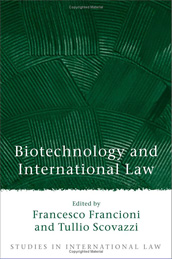BOOK REVIEW
BIOTECHNOLOGIES AND INTERNATIONAL HUMAN RIGHTS
By Francesco Francioni (ed.),
Hart Publishing, 2007, 391 pp, £60.00, ISBN-10: 1-84113-703-0

Download options |
 |
|
DOI: 10.2966/scrip.050208.432 |
||
In 2005, a group of select experts gathered at an European University Institute (EUI) colloquium held in Florence to discuss current legal instruments dealing with biotechnology and human rights, the gaps in present regulations and the need to adjust them as well as risks associated with proliferation of those rules. Biotechnologies and International Human Rights is essentially a collection of revised and edited essays resulting from that colloquium. The Book is compiled of fourteen essays by a group of renowned experts, editor Francioni included, from academia and international organisations. It is split into six sections with articles held together thematically by a focus on how current and rapid developments in biotechnology can be regulated via existing human rights principles and standards. Publications of this kind are inevitably bound to contain some repetition throughout, but this book has managed to provide the reader with a comprehensive interplay of divergent issues currently facing international human rights and biotechnology.
Part I of the book begins with Francesco Francioni questioning whether challenges facing genetic science should be explored from the human rights point of view – he subsequently answering his query in affirmative. Part II addresses bioethics and human genetics by presenting a strong case for inclusion of bioethics in biotechnology regulations. There, in Chapter 4, Roger Brownsword excitingly proclaims that the “battle for ethics must be won” which seems to be a dominant theme throughout the book. Part III, titled Economic, Social and Cultural Rights begins with a chapter examining the interface between agricultural biotechnology, the supply of and the right to food and the intellectual property concerns surrounding agricultural biotechnology. The subsequent chapter investigates the European approach to GMOs and in doing so, it refers to the EU Charter of Fundamental Rights, EU rules and regulations, concerns associated with it and remedies available. The final chapter in the same section looks at the globally controversial and vehemently debated topic of biogenetic resources of indigenous peoples and intellectual property rights.
Part IV is by far the lengthiest, reflecting on the relationship between intellectual property rights and trade issues. In chapter 10, Ernst Petersmann suggests a need for WTO bodies and members to apply principles of human rights and human dignity to international trade law. By comparison, Thomas Cottier argues that genetic engineering and biotechnology should be addressed by trade laws. He suggests that examining these technologies from a human rights perspective may be both detrimental and beneficial. Although Part V is the shortest, it is by no means the least interesting. Here, Denis Galligan analyses the role, in theory and practice, of individuals, groups and other entities in regulating biotechnology. It starts with the current regulatory system of the EU with examples of how Member States are handling issues such as embryo research, genetic engineering and likewise. The final part, Section VI considers international humanitarian law. Here, Luisa Vierucci investigates military application of biotechnologies and identifies disparities in current legislation. In doing so, she makes continuous references to the Biological Weapons Convention of 1972, Chemical Weapons Convention 1993 and Geneva Protocol of 1925 on Asphyxiating, Poisonous or other Gasses and Bacteriological Methods of Warfare.
Although, the book covers a number of diverse topics, it can be read either article by article or from cover to cover depending on the reader’s interests. One of the clearest messages from the book is that biotechnology brings about a huge number of topical issues even if only analysed from the human rights angle. Overall, Biotechnologies and International Human Rights offers a valuable insight for newcomers to the biotech debate but also appeals to those well versed in the area as it offers a human rights approach to biotechnology in much greater depth than most other books on the market. The only shortcoming noticed was that the book could have benefited from the biotechnology industry’s point of view. Nonetheless, it can be said that there is something for everyone in this book. It is a stimulating read which provides some guiding principle for further studies and research and can warmly be recommended to anyone interested in the subject.
Amina Agovic, LL.M.
PhD Candidate, IPR University Centre, Helsinki, Finland
© Amina Agovic 2008

This work is licenced under a
Creative Commons Licence.
Please click on the link to read the
terms and conditions.
